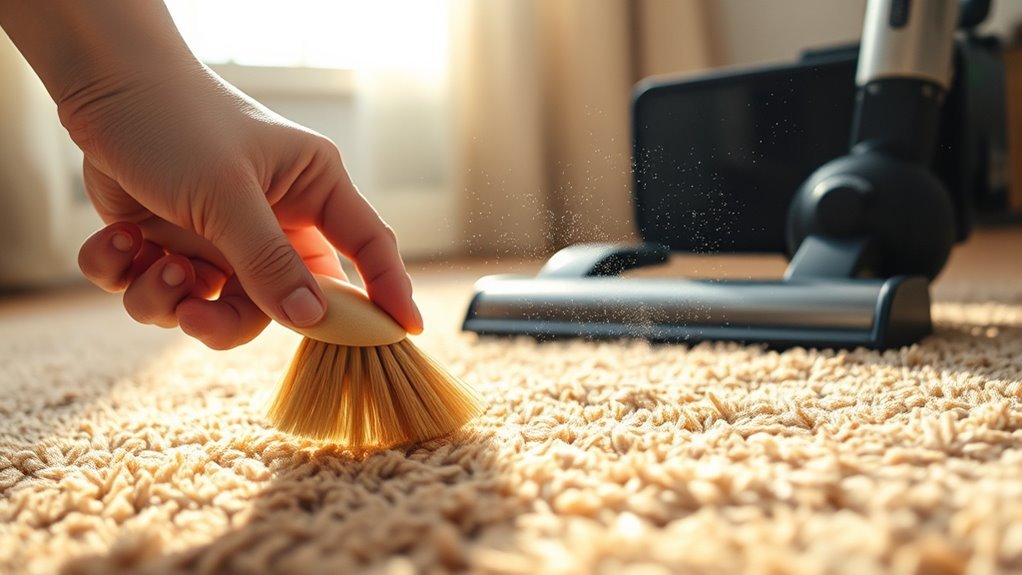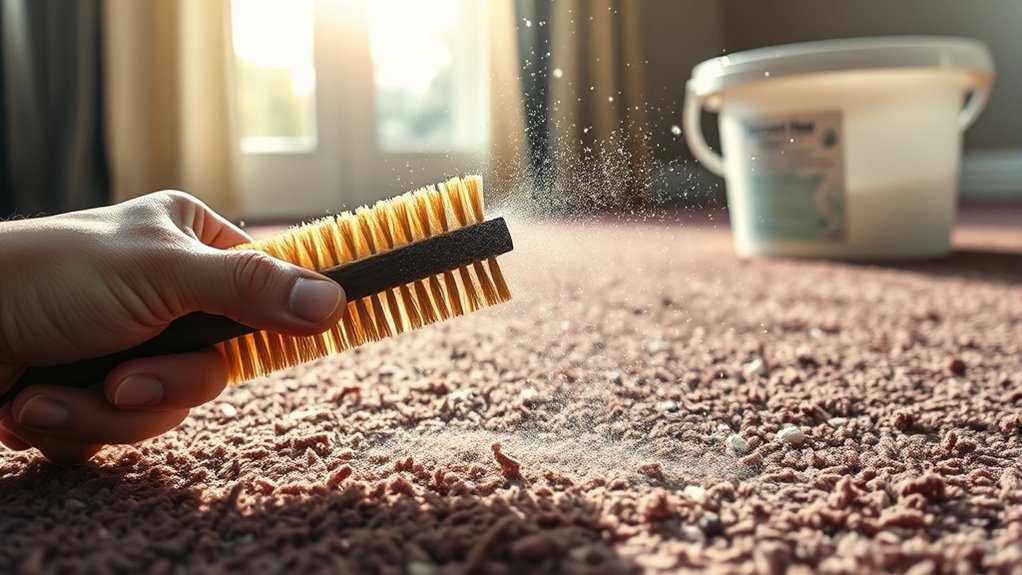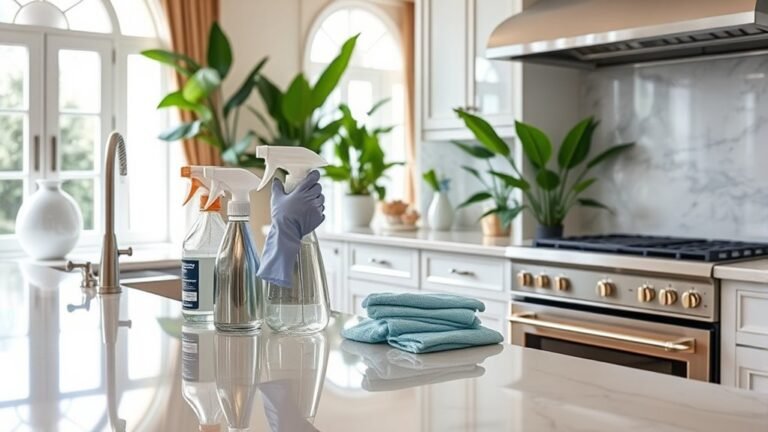Removing Dust Stains From Carpets
To remove dust stains from your carpet, start by vacuuming with a high-efficiency vacuum using slow, overlapping strokes to extract embedded dust effectively. Prepare your carpet by clearing debris and selecting a pH-neutral cleaning solution to avoid fiber damage. Gently agitate fibers with a soft brush and blot with microfiber cloths to lift stains. Control drying with proper airflow and humidity to prevent mold. Following these steps guarantees thorough restoration, and exploring further will reveal advanced cleaning and maintenance techniques.
Understanding the Causes of Dust Stains on Carpets

Although dust might seem harmless, its accumulation on carpets results from complex interactions between airborne particles, foot traffic, and environmental conditions. When you conduct a causes analysis, you’ll identify several dust sources: outdoor pollutants entering via windows or doors, skin flakes, textile fibers, and settled soil tracked indoors. These particles embed within carpet fibers through continuous foot traffic, which acts as a mechanical force pressing dust deeper into the pile. Additionally, variations in humidity and airflow affect dust adhesion and retention rates. Understanding these mechanisms empowers you to target dust stains effectively, maintaining a cleaner, freer living space. By grasping the origins and dynamics of dust accumulation, you can implement precise interventions to disrupt these processes before stains become permanent.
Tools and Materials Needed for Cleaning Dust Stains
Knowing how dust particles embed themselves into carpet fibers helps you select the right tools and materials to remove them effectively. You’ll need a high-efficiency vacuum cleaner with strong suction and a HEPA filter to extract fine dust without scattering it. For stain removal, a soft-bristle brush allows you to agitate fibers gently without causing damage. Microfiber cloths are essential for blotting and absorbing loosened dust. Additionally, a pH-neutral carpet cleaning solution prevents fiber degradation while targeting embedded dust residues. Avoid harsh chemicals that can set stains or weaken fibers. Using these specialized cleaning tools and materials guarantees you can tackle dust stains thoroughly, restoring your carpet’s appearance and preserving its integrity, granting you the freedom to maintain a clean, dust-free environment.
Preparing Your Carpet for Cleaning

Before you start cleaning, you’ll need to prepare your carpet to guarantee maximum effectiveness of the dust removal process. Begin with a thorough carpet inspection to identify dust-stained areas and determine the extent of embedded particles. This step informs your cleaning frequency to prevent dust accumulation that compromises air quality and carpet longevity. Next, clear the area completely, removing furniture and objects to access all affected zones. Finally, address any loose debris by gently sweeping or brushing the surface, avoiding deeper agitation that might embed dust further. Follow these critical steps:
Prepare your carpet thoroughly by inspecting, clearing, and gently removing loose debris before cleaning dust stains.
- Conduct a detailed carpet inspection for dust concentration and stain patterns.
- Adjust your cleaning frequency based on inspection findings and environmental factors.
- Clear and prepare the carpet area to guarantee unobstructed cleaning access.
These preparations set the foundation for effective dust stain removal.
Using Vacuum Cleaners Effectively to Remove Dust
Mastering three key vacuuming techniques will greatly improve your dust removal results. First, adjust your vacuum settings according to carpet type; higher suction for dense fibers and lower for delicate ones prevents damage while maximizing dust extraction. Second, employ specialized vacuum attachments—crevice tools for edges, upholstery brushes for stubborn dust, and motorized heads for deep pile carpets. These attachments target dust in hard-to-reach areas, enhancing thoroughness. Third, use slow, overlapping strokes to guarantee consistent coverage, preventing dust from resettling. Regularly check and replace vacuum filters to maintain peak suction power. By optimizing vacuum settings and strategically using attachments, you gain control over dust removal, freeing your space from allergens and debris efficiently. This methodical approach empowers you to keep your carpet pristine without relying on harsh chemicals.
Homemade Cleaning Solutions for Dust Stains

While vacuuming effectively removes loose dust particles, it often falls short when tackling stubborn dust stains embedded in carpet fibers. To liberate your carpet from such stains, you can employ powerful homemade cleaning solutions using accessible ingredients like homemade vinegar and baking soda. These agents combine chemical properties that break down dust particles and neutralize odors. Consider these solutions:
- A paste of baking soda mixed with water to absorb and loosen dust particles.
- A spray of homemade vinegar diluted with water, which acts as a natural solvent to dissolve dust residues.
- A sequential application where baking soda is sprinkled, then sprayed with vinegar solution, causing a fizzing reaction that lifts embedded dust.
These methods provide an effective, eco-friendly alternative that frees you from harsh chemicals and costly treatments.
Step-by-Step Guide to Cleaning Dust Stains
Before you start cleaning, make certain to clear the area and protect surrounding surfaces to prevent further contamination. Use precise dust removal techniques like vacuuming with a brush attachment to lift particles without embedding them deeper. Following these steps methodically guarantees an efficient and thorough dust stain treatment.
Preparing the Cleaning Area
Since dust stains can embed deeply in carpet fibers, you’ll need to thoroughly prepare the cleaning area to assure effective removal. Proper area preparation assures your cleaning supplies work at their full potential without interference or spread of dust.
Follow these essential steps:
- Clear the Area: Remove furniture and objects to access the entire stained surface, preventing obstruction during treatment.
- Ventilate the Space: Open windows or use fans to circulate air, reducing airborne dust and accelerating drying post-cleaning.
- Gather Cleaning Supplies: Assemble all necessary items—vacuum, specialized carpet cleaner, brushes, and cloths—within reach to maintain workflow efficiency.
Effective Dust Removal Techniques
Although dust stains can be stubborn, following a precise, methodical approach will guarantee thorough removal without damaging your carpet fibers. Start by vacuuming the affected area with a high-suction vacuum to lift loose dust particles. Next, apply a dry cleaning powder specifically designed for carpets, allowing it to absorb embedded dust for 15 minutes. Agitate gently with a soft brush to avoid fiber damage. Vacuum again to remove the powder and loosened dust. For persistent stains, use a diluted solution of mild detergent and water; apply sparingly with a microfiber cloth, blotting rather than rubbing to prevent spreading. Finish by drying the area completely to prevent mold growth. Consistent dust removal is critical for effective carpet maintenance, preserving both appearance and fiber integrity over time.
Tips for Drying and Maintaining Clean Carpets
To guarantee your carpet stays clean and damage-free, you need to use effective drying methods that prevent moisture retention and inhibit mold growth. It’s vital to control humidity and airflow immediately after cleaning to avoid mildew development. Additionally, implementing routine maintenance techniques will extend your carpet’s lifespan and maintain its appearance.
Effective Carpet Drying Methods
When you’ve thoroughly cleaned your carpet, ensuring it dries efficiently is essential to prevent mold growth and maintain fiber integrity. Mastering effective drying techniques will help you exert precise moisture control, preserving your carpet’s longevity and appearance.
- Air Circulation: Use high-powered fans to accelerate evaporation by circulating air across the carpet surface, reducing drying time considerably.
- Dehumidification: Employ a dehumidifier to extract moisture from the ambient air, preventing reabsorption by carpet fibers and subfloor.
- Temperature Management: Maintain ambient temperature between 70-75°F to optimize drying rates without damaging fibers.
Preventing Mold and Mildew
Since carpets retain moisture easily, preventing mold and mildew requires meticulous control over drying conditions and ongoing maintenance. To guarantee effective mold prevention, you must dry carpets thoroughly within 24 to 48 hours after cleaning or exposure to moisture. Utilize high-velocity fans and dehumidifiers to accelerate evaporation, maintaining indoor humidity below 50%. Proper airflow is essential—open windows and doors when possible to facilitate ventilation. For mildew control, promptly address spills and avoid carpet saturation during cleaning. Inspect carpet padding, as trapped moisture beneath the surface fosters fungal growth. Choose mold-resistant treatments or sealants to enhance protection. By rigorously managing moisture and environmental factors, you safeguard your carpets from microbial damage while retaining their structural integrity and appearance, guaranteeing freedom from persistent mold and mildew issues.
Routine Carpet Maintenance Tips
Maintaining dry carpets is just one part of a thorough care routine that preserves their condition and extends their lifespan. To keep your carpets pristine, you must integrate precise actions into your maintenance schedule. Start with:
- Regular vacuuming – Remove dust and debris consistently to prevent particle buildup that damages fibers.
- Use carpet protectors – Place these under heavy furniture to avoid permanent indentations and fiber stress.
- Ensure proper drying – After cleaning or spills, use fans or dehumidifiers to eliminate moisture swiftly, preventing mold growth and fiber weakening.
Preventative Measures to Reduce Dust Accumulation
Although dust accumulation on carpets is inevitable, implementing targeted preventative measures can greatly reduce its buildup and simplify maintenance. To minimize dust infiltration, consider integrating air purifiers benefits into your environment; these devices effectively capture airborne particles before they settle on surfaces. Additionally, selecting dust resistant fabrics for upholstery and carpet fibers can substantially lower dust adherence by repelling fine particles. Regularly maintaining HVAC systems with quality filters complements these strategies by reducing indoor dust circulation. Limiting foot traffic in carpeted areas and establishing no-shoe policies further prevents external dust introduction. Employing these methods systematically grants you greater control over dust levels, preserving carpet appearance and extending its lifespan, ultimately giving you the freedom to enjoy a cleaner, healthier living space with less frequent intensive cleaning.
When to Seek Professional Carpet Cleaning Services
If your carpet shows persistent stains, odors, or deep-seated dust that regular cleaning can’t remove, it’s time to contemplate professional carpet cleaning services. Experts provide professional assessments that accurately diagnose the extent of contamination and damage, guiding you toward effective carpet restoration. Consider calling professionals when you encounter:
Persistent stains or odors beyond regular cleaning signal the need for professional carpet care and restoration.
- Embedded Dust and Allergens: Invisible particles deeply lodged in fibers that trigger allergies or respiratory issues.
- Stubborn Stains and Odors: Residues resistant to conventional treatments, indicating chemical or biological breakdown.
- Worn or Damaged Fibers: Signs of fiber degradation requiring specialized techniques to restore texture and appearance.
Seeking professional intervention guarantees your carpet’s longevity, improves indoor air quality, and frees you from ineffective DIY attempts, granting you freedom from persistent dust stains.
Frequently Asked Questions
Can Dust Stains Cause Allergies or Health Issues?
Yes, dust stains can contribute to dust allergies and pose health risks. When dust accumulates, it often harbors allergens like dust mites, mold spores, and pet dander, which you might inhale. This can trigger allergic reactions, respiratory issues, and exacerbate conditions such as asthma. To safeguard your health and maintain a clean environment, it’s essential you address dust buildup promptly and use effective cleaning methods to minimize exposure to these allergens.
How Often Should Carpets Be Deep Cleaned Professionally?
Think of your carpet maintenance like clockwork: to keep it in prime condition, professional deep cleaning should occur every 12 to 18 months. This cleaning frequency guarantees embedded dirt, allergens, and dust mites are thoroughly eliminated, preserving your carpet’s fibers and indoor air quality. If you have pets or high foot traffic, you might want to increase the frequency to every 6-12 months for ideal hygiene and longevity, granting you the freedom to enjoy a healthier home environment.
Are Certain Carpet Fibers More Resistant to Dust Stains?
Yes, you’ll find that synthetic fibers like nylon and polyester are generally more resistant to dust stains compared to natural fibers such as wool or cotton. Synthetic fibers repel dust better due to their smooth surfaces and less porous structure, making them easier to clean and maintain. Natural fibers, while luxurious, tend to trap dust more readily, requiring more frequent cleaning to maintain their appearance and durability.
Can Air Purifiers Help Reduce Carpet Dust Accumulation?
Imagine you run a busy home office where dust constantly settles. Using an air purifier with HEPA filters can greatly improve air quality by trapping airborne particles, leading to noticeable dust reduction. This means less dust settling on your carpet fibers, helping maintain a cleaner environment. While air purifiers won’t eliminate all dust accumulation, they’re a proven technical solution to reduce airborne contaminants, giving you more freedom from constant carpet cleaning.
Is It Safe to Use Commercial Carpet Cleaners on All Carpets?
You shouldn’t assume commercial carpet cleaners are safe for all carpet types. Different carpets—like wool, nylon, or polyester—react uniquely to cleaning ingredients. Harsh chemicals can damage natural fibers or alter synthetic ones, so always check the cleaner’s formulation and test it on a hidden area first. Knowing your carpet’s material and the specific ingredients guarantees you maintain its integrity without risking discoloration or weakening of fibers.






